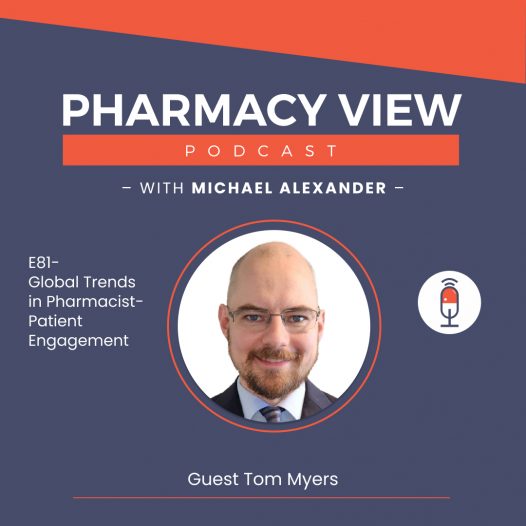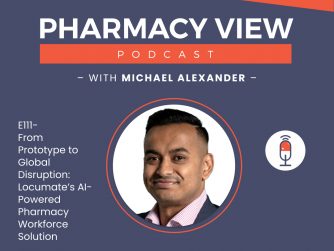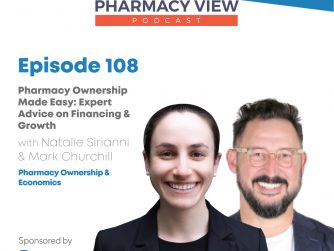In this episode of the Pharmacy View Podcast’s Rx to Riches stream, host Michael Alexander, a Pharmacist, entrepreneur, digital health enthusiast, Co-Founder of Audirie, and the Regional Vice-President of Health Plans at Omada Health, is joined by Tom Myers, Pharmacy Manager at Walgreens. Listen in as Tom talks about their journey, innovations in Pharmacy, and the challenges of balancing clinical care with business demands.
Tom’s journey into Pharmacy began in high school when they gained hands-on experience in Hospital Pharmacy practice in Salem, Oregon, sparking their passion for chemistry and Pharmacy. After completing an undergraduate degree in microbiology with a chemistry minor at Oregon State University, Tom entered the Pharmacy program.
Having risen from intern to staff Pharmacist, Tom eventually stepped into the role of Pharmacy Manager, particularly during the onset of the COVID-19 pandemic. Tom discusses the advantages of their managerial role, emphasizing the opportunity to shape projects according to their vision and streamline operations.
Tom shares further insights into the innovative technological advancements implemented by Walgreens to enhance patient convenience and streamline Pharmacy operations. They highlight features of the Walgreens app, such as digital text reminders and insurance card updates, reducing wait times and phone calls. Tom also mentions the introduction of 90-day medication supplies and the adoption of micro-fulfillment technology.
Tom explores the challenges and opportunities related to reimbursement for clinical knowledge and services in Pharmacy, emphasizing the need for reimbursement even for negative test results. They also discuss Walgreens’ national engagement program and express a desire to see more community clinics in the future, recognizing staffing challenges as a key consideration for such projects.
Lastly, Tom Myers emphasizes the need for innovative approaches to discover new income methods in the evolving landscape of Pharmacy, acknowledging the challenge of finding alternative revenue streams while balancing clinical care with business obligations. They also stress the importance of qualities such as attention to detail, a clear vision, courage in decision-making, and staying true to one’s ethics in the Pharmacy profession.
Topics Covered
- Tom Myers’ journey into Pharmacy
- Transforming Pharmacy operations
- Walgreens’ tech-driven convenience
- Pharmacy reimbursement
- Pharmacy of the Future
- Evolution of prescription
- Traits needed to thrive in Pharmacy
- Challenges of modern Pharmacy management
Key Quotes (Time Stamps)
- “And so, when I got to see how practicing Pharmacy is in the hospital setting, I figured out this is kind of the career that I wanted to go down.” (1:50 – 1:57)
- “What I like more about being a manager there rather than the staff Pharmacist is you can have your own vision on how you want projects to be laid out and executed. And so, I liked the idea of me tossing out my ideas and seeing how they actually played out.” (3:27 – 3:43)
- “So, the role is to try to take away the administrative day-to-day tasks like ordering and such. So, it can focus on those more clinical aspects and more of the Pharmacy of the future where we do more patient engagement, more immunizations, more testing, and more clinical aspects in order to free up that time; that’s why that position was created.” (5:47 – 6:11)
- “Walgreens has taken a lot of advances in this area, particularly with going digital. If you sign up through the Walgreens app, you can get digital text reminders that your prescriptions are ready. You can also get calls from our Pharmacy staff that the medication has been ready for a couple of days just to make sure that this is something that you still need to take. Also, with the app, if your insurance changes, you can take a picture of your card, and then, we get a fax with all that information on it so we can update your profile so there are no longer waits in line so your insurance is available more quickly.” (6:44 – 7:06)
- “Other states have utilized this permit called Micro-fulfillment. So basically, it’s a big warehouse with a bunch of robots, technicians, and Pharmacists. And what they do is they specialize in pre-counting all the medications, and then they’re packaged up and then sent to the local Pharmacy. So, this particular warehouse, I think in Arizona, about 50,000 prescriptions a day—they pack them up, and then they’re sent to the local Pharmacies the next day. And so that’s just less time that a tech assistant needs to fill it and less time for the Pharmacist to review it since it’s already packaged up and sent to the Pharmacy the next day. And so, the goal of the Pharmacy of the future for Walgreens is to try to alleviate those more administrative tasks and focus on more of that clinical aspect.” (8:01 – 8:49)
- “For Walgreens, the main focus was to try to utilize more of the Pharmacists’ knowledge rather than keep them in that administrative role. And so, a part of this ‘Pharmacy of the Future’ is trying to open up that time so Pharmacists have the opportunity to take those clinical opportunities.” (16:23 – 16:37)
- “I’d be interested to think or to understand from your point of view what the split is in terms of how much revenues are generated from the front of the shop versus prescription. So, I know in Australian Pharmacy, for many Pharmacies, especially smaller ones, it tends to be 80/20 or 70/30 where the said 70- 80% of income comes from prescriptions and filling prescriptions, and only 20-30% may come from the front of the shop.” (26:50 – 27:17) – Michael Alexander
- “I would say attention to detail is key in pretty much any aspect that you do, whether it’s reviewing prescriptions or it’s making sure you make the right hire, making sure patients know all, the side effects that they need for their certain medications.” (29:45 – 30::02)
- “Also, having a vision. When I became a manager, I had been with Walgreens for four or five years, so I kind of knew what I wanted my Pharmacy to look like. I knew the flow and rotation and how things wanted to go because I knew that would be the most efficient. And because of that experience, I think I was really good when I first started this because I knew what I wanted my Pharmacy to be.” (30:03 – 30:28)
- “Being courageous and not being afraid to make mistakes—there’s going to be tough decisions pretty every day or some more important than others, but it’s more important that you are true to yourself and true to your ethics when you’re making your decision. So, when you look back, you know that you made the right choices.” (30:32 – 30:52)
- “But what makes my job so rewarding is when you find those patients that recognize how much work and effort goes into the work that we do. And so, when they say thank you, you kind of get that affirmation that you’re doing what you’re supposed to do.” (31:08 – 31:22)
- “I love the work that I do, and I can’t wait to see where the profession goes five years from now, ten years from now. And I feel like we’re heading in the right direction.” (32:23 – 32:31)
- “I’d say one of the most challenging parts is balancing everything that you were taught in Pharmacy school with the business side of driving metrics.” (33:10 – 33:23)
Social Media Clips (Time Stamps)
- Stepping Up During a Pandemic: Tom’s Role as a Pharmacy Manager (1:22 – 3:16)
- Transforming Pharmacy Operations: Tom’s Innovative Approach (3:21 – 5:15)
- From Robots to Clinical Care: Walgreens’ Tech Transformation (6:12 – 8:49)
- Protecting Communities: Walgreens’ Collaborative CDC Efforts (9:51 – 12:07)
- From Red Noses to Real Change: Walgreens’ Fight Against Child Poverty (13:52 – 15:32)
- Pharmacist’s Potential in the Pharmacy of the Future (15:33 – 17:58)
- Prescribing Power: How Oregon’s Pharmacies are Changing the Game (20:56 – 23:01)
- Pharmacy Revenue Beyond Prescriptions (25:00 – 26:39)
- Vision, Courage, and Detail: Tom’s Keys to Thriving in Pharmacy (29:25 – 31:26)
- Tom Myers on Navigating the Balancing Act in Pharmacy (32:36 – 35:00)








